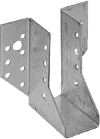Floor beams or ceiling joists are the supporting structure of the house, therefore, before you begin to independently install floor joists in a log house or bathhouse, we strongly recommend that you take special care approach the choice of material And calculate correctly floor construction.
For the manufacture of floor joists, it is best to use dry, first-grade material impregnated with a fire-bioprotective composition.
Beams are most often embedded:

How to ensure the strength of floors and convenient installation
Having previously marked the places where the beams will be inserted, cuts are made in the log and tight beams are inserted into them at a distance of about 600 mm from each other. This distance between the beams provides the necessary strength of the floors. Most types of insulation are produced exactly 600 mm wide, which ensures convenient installation of heat and noise insulation. With this method of installing logs, there is no need to attach them additionally to the wall.

Floor joists can also be mounted after the frame has been assembled, securing them to the wall using special brackets and screws. The construction market now hasa huge variety of fastening devices. But more correct and reliable installation method - first!
Questions arising during the construction process
During construction log house, log bathhouse Questions naturally arise: What section should I embed the floor beams (floor, ceiling)? What load can wooden joists (beams) withstand? What is the maximum beam length possible for what section of board, beam, or log? 
Based on the table below, it is easy to calculate the cross-section of the log, depending on its length. The data is given for standard spans with a width of 2 to 6 meters, with a frequency of lags every 600 mm (distance between lags 600 mm) Design load 300 kg per 1 sq. meter. The table shows the breaking loads for these logs in kg per square meter.
Simply put, the numbers on a colored background are the load in kilograms per 1 m2, at which the ceiling will simply break. But in order to prevent the floor from “springing”, there is also an indicator of the bending of the beam. Blue background - the floor will not “spring”, yellow - the maximum permissible, and red background the floor will sag under a load of 300 kg more than the permissible norm.
Table for calculating the destructive load (kg/m2) on the joists (beams) of the floors of a log house.
| log length m | 2,0 | 2,5 | 3,0 | 3,5 | 4,0 | 4,5 | 5,0 | 5,5 | 6,0 |
| log section mm | |||||||||
| Board 100x50 | 733 | 587 | 489 | 419 | 367 | 326 | 293 | 267 | 244 |
| Board 150x50 | 1650 | 1320 | 1100 | 943 | 825 | 733 | 660 | 600 | 500 |
| Board 200x50 | 2933 | 2347 | 1956 | 1676 | 1467 | 1304 | 1173 | 1067 | 978 |
| Beam 200x100 | 5867 | 4693 | 3911 | 3352 | 2933 | 2607 | 2347 | 2133 | 1956 |
| Beam 200x200 | 11733 | 9387 | 7822 | 6705 | 5867 | 5215 | 4693 | 4267 | 3911 |
| Log 200 | 6912 | 5529 | 4608 | 3949 | 3456 | 3072 | 2765 | 2513 | 2304 |
| Log 220 | 9199 | 7359 | 6133 | 5257 | 4600 | 4089 | 3680 | 3345 | 3066 |
Blue are highlighted in the table values with safety margin
Yellow the values are highlighted in the table maximum permissible by beam deflection for these conditions
In red values are highlighted unacceptable for deflection(more than twice the permissible norm) of beams for these conditions.
Note: additional rigidity can also be given to the beam by splicing two or more boards in thickness. 









